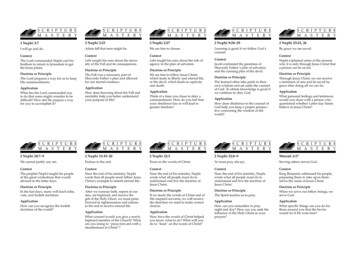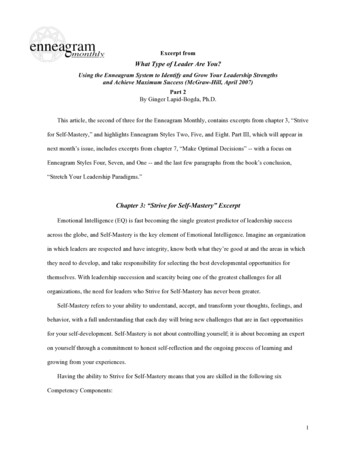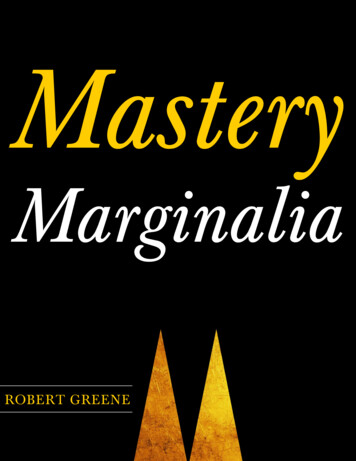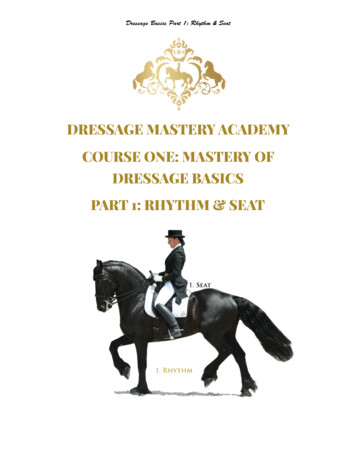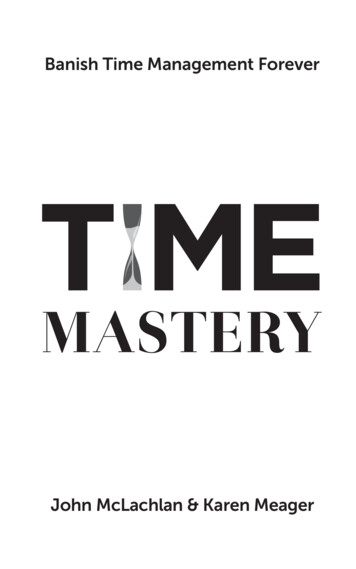
Transcription
UNDERSTANDING THE MASTERY-AVOIDANCE GOALS CONSTRUCT:AN INVESTIGATION AMONG MIDDLE SCHOOL STUDENTS IN TWO DOMAINSA DissertationSubmitted to theTemple University Graduate Boardin Partial Fulfillmentof the Requirements for the DegreeDOCTOR OF PHILOSOPHYbyMelissa KarakusMay 2016Examining Committee Members:Avi Kaplan, Advisory Chair, Educational PsychologyLaura Pendergast, School Psychology ChairJulie L. Booth, Educational PsychologyJoseph DuCette, Educational Psychology
iiABSTRACTThis dissertation addressed knowledge gaps concerning “mastery-avoidancegoals”—a construct within the prominent motivational perspective Achievement GoalTheory. Mastery-avoidance goals refer to students’ engagement in an achievement taskwith the purpose of avoiding failure to develop competence. While it was introduced tothe achievement goal literature over a decade and a half ago, the construct of masteryavoidance goals still lacks intuitive relevance, conceptual clarity, and evidence ofprevalence among young students. In addition, so far, research has not established clearpatterns of relations of mastery-avoidance goals with the other personal achievementgoals (mastery-approach, performance-approach, and performance-avoidance), withcontextual motivational emphases, or with adaptive and maladaptive educationaloutcomes. This dissertation aimed to contribute to knowledge in these gaps byinvestigating mastery-avoidance goals among middle school students in two subjectdomains that concern different types of competence: science and instrumental music.The dissertation describes two studies. In Study 1, I administered a self-reportmeasure to middle school students (N 126) that included summated scales to investigatethe empirical distinction between mastery-avoidance goals and other achievement goals,the components of its conceptual definition, its prevalence of adoption by young studentsin the two different domains, as well as its relations with contextual emphases andadaptive and maladaptive educational outcomes. Multidimensional scaling analysisindicated that while students in both science and instrumental music made a distinctionbetween mastery and performance goals, these students did not make a completedistinction between mastery-approach and mastery-avoidance goals, at least according to
iiithe conceptual definition investigated in these studies. Regression analyses indicated thatstudents’ perceptions of their teachers’ emphasis on mastery-approach and masteryavoidance goals were significantly related to their reports of mastery-avoidance goals.Cluster analysis suggested a pattern of two general motivational profiles in the sample ofmore and less motivated students that differed on their simultaneous and respective highand low endorsements of both mastery-approach and mastery-avoidance goals, intrinsicand extrinsic motivation, sense of academic efficacy, and also academic achievement.In Study 2, I aimed to further knowledge of the meaning that students make ofmastery-avoidance goals by examining students’ (N 79) qualitative responses toquestions asking them to interpret items from the summated-scales self-report measure.Findings from a qualitative content analysis supported the findings from Study 1 aboutstudents’ lack of distinction between mastery-approach and mastery-avoidance goals, andindicated that students interpreted mastery-avoidance goals items in ways that weredifferent from those intended by the researchers. These findings suggested that studentsform meanings of mastery-avoidance goals that are potentially different from the formalconceptual definition in the literature.The findings are interpreted as suggesting that students’ meaning-making aboutmastery-avoidance goals in both science and instrumental music may be contextualizedby their personal characteristics (e.g., age), by characteristics of their school andclassroom environments, and by situational characteristics (e.g., proximity of evaluativetasks). Further research should investigate systematically the different personal andcontextual factors that may contribute to the meaning students make of masteryavoidance goals.
ivACKNOWLEDGEMENTS AND DEDICATIONI am grateful to many people who helped me along this journey: my advisor andmentor, Avi Kaplan, your contagious passion, patience, understanding, and kindness havebeen invaluable; Julie Booth, Joseph DuCette, and Laura Pendergast, for taking the timeto lend your support and feedback.; Ting Dai, Tony Perez, Bradley Bergey, Ted Wills,and others from my time at Temple, for all of the support offered to me throughout ourgraduate school years and beyond, and the privilege to be able to call you friends as wellas colleagues; my friends at 440, my deepest appreciation for your support bothprofessionally and personally.To my parents- I would never be where I am today without your constant love andsupport. The many sacrifices you have made in order for me to succeed have never goneoverlooked.My husband Oz- while at times I may not have shown it, words cannot expressmy appreciation for your patience, support, and partnership through the many years thiswork has been in progress. I look forward to many more years together.I dedicate my dissertation to my children Sophia, and soon-to-be-born, Luca.Sophia, please never set any goal that is less than what you want, and never let anyonetell you that you can’t achieve it. Luca, thank you for giving me the timeline I needed tofinish this work and reach my goal. I can’t wait to meet you.
vTABLE OF CONTENTSABSTRACT. iiACKNOWLEDGEMENTS AND DEDICATION . ivLIST OF TABLES . viiiLIST OF FIGURES . xCHAPTER 1. INTRODUCTION . 1Achievement Goal Theory . 2Competence Standards: Two Achievement Goals. 2Competence Valence: Three Achievement Goals . 3Avoidance of Failure Valence in Mastery Goals: Four Achievement Goals . 4Outcomes Related to Achievement Goals . 5Remaining Questions Regarding Mastery-Avoidance Goals . 9Main Research Questions . 10Overview of Chapters . 11CHAPTER 2. LITERATURE REVIEW . 13Conceptual Definition of Mastery-Avoidance Goals . 14Phenomenological Meaning of mastery-avoidance goals . 16Operationalization and Methodology . 18Prevalence and Relevance . 23Research Questions and Hypotheses . 31CHAPTER 3. METHODOLOGY . 35Study 1 . 35Participants . 36Sex, Grade, and Ethnicity . 36Parental Level of Education . 36
viAcademic Achievement . 37Measures . 38Demographics Questionnaire . 38Patterns for Adaptive Learning Survey (PALS) . 38Personal Mastery-Avoidance Goals . 41Achievement goal structures (Perception of Teacher’s Goals) . 43Achievement goal structures (Perception of Teacher’s Goals) Mastery-Avoidance . 46Intrinsic and Extrinsic Motivation . 48Academic Efficacy. 49Procedure . 51Timing . 53Screening for Assumptions . 53Data Analyses . 54Study 2 . 57Participants . 58Measures . 59Procedure. 59Analyses . 59CHAPTER 4. RESULTS . 63Study 1 . 64Section 1: Exploratory Factor Analysis (EFA) . 64Section 2: Descriptive Statistics. 65Section 3: Correlations . 68Section 4: Multi-Dimensional Scaling . 79Section 5: Multiple Regression . 91
viiSection 6: Cluster Analysis . 94Results: Study 2 . 97Chi-square Tests. 97Students’ Interpretation of Items. 98CHAPTER 5. DISCUSSION . 110Empirical Distinctions . 111Prevalence of Mastery-avoidance Goals . 115Mastery-avoidance Goals and Teachers’ Goal Structures . 116Mastery-avoidance Goals and Academic Outcomes . 118Limitations . 120Implications and Future Directions . 122Conclusion . 123REFERENCES . 125APPENDIX A. DEMOGRAPHIC QUESTIONNAIRE . 135APPENDIX B. QUESTIONNAIRE ASSESSING PERSONAL ACHIEVEMENT GOALS,PERCEPTION OF TEACHER’S GOALS, ACADEMIC EFFICACY, ANDINTRINSIC/EXTRINSIC GOALS . 137APPENDIX C. CODE BOOK . 143
viiiLIST OF TABLESTable 1. Participant Demographic Information . 37Table 2. Pattern Matrix for EFA of Mastery-approach and Mastery-avoidance Goal Variables . 65Table 3. Descriptive Statistics of Variables by Domain . 66Table 4. Achievement Goal Endorsement in Science and Instrumental Music . 67Table 5. Bivariate Correlations among personal achievement goals, extrinsic/intrinsic motivation,academic efficacy, and achievement in both science and instrumental music. 1Table 6. Bivariate Correlations between personal achievement goals and teachers' goal structures. 74Table 7. Bivariate correlations between teachers' goal structure and academic efficacy, extrinsicmotivation, intrinsic motivation, and achievement . 78Table 8. Summary of Results for Variables Predicting Mastery-avoidance goals. 92Table 9. Summary of Results for Variables Predicting Mastery-approach goals . 93Table 10. Summary of Results for Variables Predicting Performance-approach goals . 94Table 11. Percentages of students' interpretation that matched the Intended Meaning of Items(N 79). 99Table 12. Percentage of Student Matches by Likert-choice, Mastery-approach (N 78). 101Table 13. Percentage of Student Matches by Likert-choice, Mastery-avoidance, Intrapersonal(N 75). 101Table 14. Percentage of Student Matches by Likert-choice, Mastery-avoidance, Task-based(N 74). 101Table 15. Percentage of Student Matches by Likert-choice, Performance (N 72) . 102Table 16. Percentage of Student Matches by Likert-choice, Performance-approach (N 78) . 102Table 17. Breakdown of matches by Likert-item, Mastery-approach . 102Table 18. Breakdown of matches by Likert-item, Master-avoidance, intrapersonal . 102Table 19. Breakdown of matches by Likert-item, Mastery-avoidance, Task-based . 103Table 20. Breakdown of matches by Likert-item, Performance-avoidance. 103Table 21. Breakdown of matches by Likert-item, Performance-approach . 103
ixTable 22. Counts of Students' Interpretation that Mismatched the Mastery-approach item . 104Table 23. Counts of Students' Interpretation that Mismatched the Mastery-avoidance,intrapersonal item. 104Table 24. Counts of Students' Interpretation that Mismatched the Mastery-avoidance, task-baseditem . 104Table 25. Counts of Students' Interpretation that Mismatched the Performance-avoidance item104Table 26. Counts of Students' Interpretation that Mismatched the Performance-approach item. 105Table 27. Counts of Student Mismatches by Likert-choice, Mastery-approach . 106Table 28. Counts of Student Mismatches by Likert-choice, Mastery-avoidance, Intrapersonal . 106Table 29. Counts of Student Mismatches by Likert-choice, Mastery-avoidance, Task-based . 106Table 30. Counts of Student Mismatches by Likert-choice, Performance-avoidance . 107Table 31. Counts of Student Mismatches by Likert-choice, Performance-approach. 107Table 32. Breakdown of Mismatches by Aspect, Mastery-approach . 107Table 33. Breakdown of mismatches by Aspect, Mastery-avoidance, intrapersonal . 107Table 34. Breakdown of mismatches by Aspect, Mastery-avoidance, Task-based . 108Table 35. Breakdown of mismatches by Aspect, Performance-avoidance . 108Table 36. Breakdown of mismatches by Aspect, Performance-approach . 108Table 37. Counts of Participants (N) who were coded as a '0' across the three aspects for eachitem . 109
xLIST OF FIGURESFigure 1. 2 Dimensional MDS of All Achievement Goals for All Participants. 80Figure 2. 2 Dimensional MDS of MAV Competence Standards for all Participants . 81Figure 3. 2 Dimensional MDS of All Achievement Goals, All Science Participants . 83Figure 4. 2 Dimensional MDS of All Goals, Matched Science Group . 84Figure 5. 2 Dimensional MDS of All Achievement Goals in Instrumental Music . 86Figure 6. 2 Dimensional MDS of Mastery-Approach and Mastery-Avoidance Goals for MatchedScience Participants . 87Figure 7. 2 Dimensional MDS of MAP and MAV goals for Instrumental Music . 88Figure 8. 2 Dimensional MDS of MAV goals, Science. 89Figure 9. 2 Dimensional MDS of MAV goals, Music . 90
CHAPTER 1. INTRODUCTIONAchievement goals, which refer to the reasons or purposes that guide students’engagement in academic tasks, have become central constructs in the contemporarymotivational literature (Graham & Weiner, 2012). Research has established the relevanceand prominence of three achievement goals to understanding students’ engagementpatterns: mastery-approach, performance-approach, and performance-avoidance goals.However, a more recent construct in the theory—mastery-avoidance goals—which refersto engagement in academic tasks with the purpose of avoiding not developingcompetence, has received far less attention. Whereas research on mastery-avoidancegoals has been increasing (Bong, 2009), many questions remain. The conceptualdefinition of mastery-avoidance goals is not completely clear. Moreover, there is a lackof theoretical clarity and empirical evidence concerning the phenomenological meaningof mastery-avoidance goals, their actual prevalence and relevance, the appropriate way tooperationalize them methodologically, and their associated outcomes, particularly amongyoung students, and in different subject domains. Therefore, this dissertation sought toinvestigate how middle school students make sense of the goals aimed at avoiding notdeveloping competence, and how the meaning, prevalence, and relevance of masteryavoidance goals among middle-school students differ in two different subject domains:science and instrumental music. Finally, this dissertation investigated the relationsbetween mastery-avoidance goals and students’ perceptions of their classrooms’ goalstructure, as well as outcome patterns of intrinsic/extrinsic motivation, academic efficacy,and academic achievement.
2Achievement Goal TheoryOver the last couple of decades, achievement goal theory has emerged as adominant theory of achievement motivation (Elliot & McGregor, 1999; Graham &Weiner, 2012; Pintrich & Schunk, 2002;). As competence is central to achievementsituations such as those in educational settings (Elliot & Dweck, 2005), achievement goaltheory has focused on competence strivings (Maehr, 1989). Specifically, the centralconcept in the theory—achievement goals—refers to the reasons and purposes thatconcern competence in achievement tasks. The achievement goals that have dominatedthe literature in achievement goal theory for decades concern the purposes of developingor demonstrating competence (Ames, 1992; Dweck, 1986; Maehr, 1989; Nicholls, 1984).Competence Standards: Two Achievement GoalsTheorists have used various labels for achievement goals, each having slightlydifferent meanings. However, during the 1980s and ‘90s, most achievement goalresearch converged to focus on two types of achievement goals and followed CaroleAmes’ (1992) labels for these goals: Mastery goals and Performance goals.Mastery goals refer to a focus on developing competence. Students are said topursue mastery goals when they engage in achievement tasks with the orientation towardsdeveloping their competence, and seek feedback that indicates success in competencedevelopment along task-based standards, such as mastering knowledge or a skill, or intrapersonal standards, such as improving over a previous level of performance (Elliot &McGregor, 1999).Performance goals refer to a focus on demonstrating competence, particularlyrelative to other students (Ames, 1992; Nicholls, 1984). Students who pursue
3performance goals are oriented towards demonstrating their competence and seekfeedback that indicates success in demonstrating their competence along inter-personalstandards such as outperforming other students (Elliot & McGregor, 1999).Competence Valence: Three Achievement GoalsIn the late 1990s, Elliot and colleagues proposed that the achievement valence ofapproaching success or avoiding failure should be incorporated into achievement goaltheory (Elliot & Church, 1997; Elliot & McGregor, 1999; Elliot & Harackiewicz, 1996).There is much literature on approach and avoidance strivings in achievement motivation,as it had been considered relevant and important already by early theorists (e.g., Murray,1938; see Elliot & Covington, 2001). Early theories viewed achievement motivations asframed by two basic personality-based needs: the need for success and the need to avoidfailure. These needs are assumed to sensitize the individual to the possibility of successor to the possibility of failure, respectively. They manifest when a person is faced with anachievement situation where actions may lead to success or failure. Individuals with highneed for success will tend to approach the situations with the primary orientation ofhoping for success and seeking pride in their accomplishment, whereas individuals withhigh need to avoid failure tend to approach the situation with the primary orientation ofwanting to avoid failing and seeking to avoid embarrassment or shame (Atkinson, 1957,1964; McClelland 1951).Whereas mastery goals were considered to have only the valence of approachingsuccess, Elliot and Church (1997) argued that performance goals might be pursued eitherwith an approaching success valence or with an avoidance of failure valence. Thus, theinitial incorporation of approach and avoidance valence into achievement goal theory
4yielded three achievement goals—a trichotomous model—with mastery, performanceapproach, and performance-avoidance goals. In this model, mastery goals wereconceptualized as an orientation towards approaching success in developing competencealong task-based and/or intra-personal standards; performance-approach goals wereconceptualized as an orientation towards approaching success in demonstratingcompetence along inter-personal, or normative, standards; and performance-avoidancegoals were conceptualized as an orientation towards avoiding failure in demonstratingcompetence along inter-personal, or normative, standards (Elliot & Church, 1997; Elliot& McGregor, 2001).Avoidance of Failure Valence in Mastery Goals: Four Achievement GoalsA little over a decade ago, and only a few years following the incorporation of theapproach-avoidance valence into performance goals, Elliot and McGregor (1999)suggested that the valence of avoidance of failure should also be applied to mastery goals(see also Pintrich, 2000a; Pintrich, 2000b). Mastery-avoidance goals were conceptualizedas an orientation towards avoiding failure in developing competence along intra-personaland/or task-based standards. Examples of avoiding failure, evaluated along standards oftask-mastery or self-referenced change in competence, could include trying to avoidmisunderstanding material in class and striving to avoid forgetting things learned in acourse. Adding mastery-avoidance goals to the trichotomous model created a “2x2”model of achievement goals, with two types of competence standards (mastery andperformance) and two types of valence (approach and avoidance) (Elliot & McGregor,2001).
5More recently, Elliot and colleagues made the argument that the task-basedstandards and self-referenced standards in mastery goals should be differentiated intodistinct strivings. Thus, the two valences of approach and avoidance were suggested to becombined with three, rather than two standards of competence—task-based, selfreferential, and other-based standards of competence—yielding six separate achievementgoal constructs (Elliot, Murayama, & Pekrun, 2011). This model is quite new and lacksextensive empirical support.Outcomes Related to Achievement GoalsResearchers continue to investigate the processes and outcomes underlying andassociated with different achievement goals. Literature over the past few decades hasestablished that different achievement goals are associated with different achievementrelated outcomes such as help-seeking, study skills and strategies, affective reactions,adaptive and maladaptive patterns of behavior, and academic achievement (Church,Elliot, & Gable, 2001; Elliot & McGregor, 1999; Hulleman et al., 2010; Roussel, Elliot,& Feltman 2011).Performance GoalsEarly research in achievement goal theory that focused on the two-goal modelprimarily sought to compare the associations between mastery and performance goalswith various academic and affective outcomes. The findings of this research mostlyindicated that performance goals were associated with a less adaptive pattern of outcomesthan were mastery goals (Dweck, 1986; Nicholls, 1984). However, the pattern of findingsrelating outcomes to performance goals was mixed. Many studies found performancegoals to be associated with a maladaptive pattern of outcomes, or with a less adaptive
6pattern of outcomes than were mastery goals (Ames & Archer, 1988). Yet, some studiesfound performance goals to have no association with maladaptive outcomes, whereasothers found performance goals to be as adaptive as mastery goals (Urdan, 1997). Elliotand Church (1997) and Pintrich (2000) suggested that this mixed pattern of outcomes wasdue to the confounding of performance-approach and performance-avoidance goals.Subsequent research investigated the differential associations of these two performancegoals with different outcomes.Following the conceptual distinction between performance-approach andperformance-avoidance goals, much attention has been paid to the association ofperformance-approach goals relative to that of mastery goals with academic achievement.While some studies found positive relationships between performance-approach goalsand high academic achievement (scores on tests), grades, and (academic) self-efficacy(Church, Elliot & Gable, 2000; Elliot & McGregor, 1999; Elliot & Church, 1997), otherstudies found no such relationships. For example, Elliot and McGregor (1999), wholooked at undergraduate students’ grades in an introductory psychology course, inaddition to participants’ test anxiety,
goals (mastery-approach, performance-approach, and performance-avoidance), with contextual motivational emphases, or with adaptive and maladaptive educational outcomes. This dissertation aimed to contribute to knowledge in these gaps by investigating mastery-avoidance goals among middle school students in two subject
